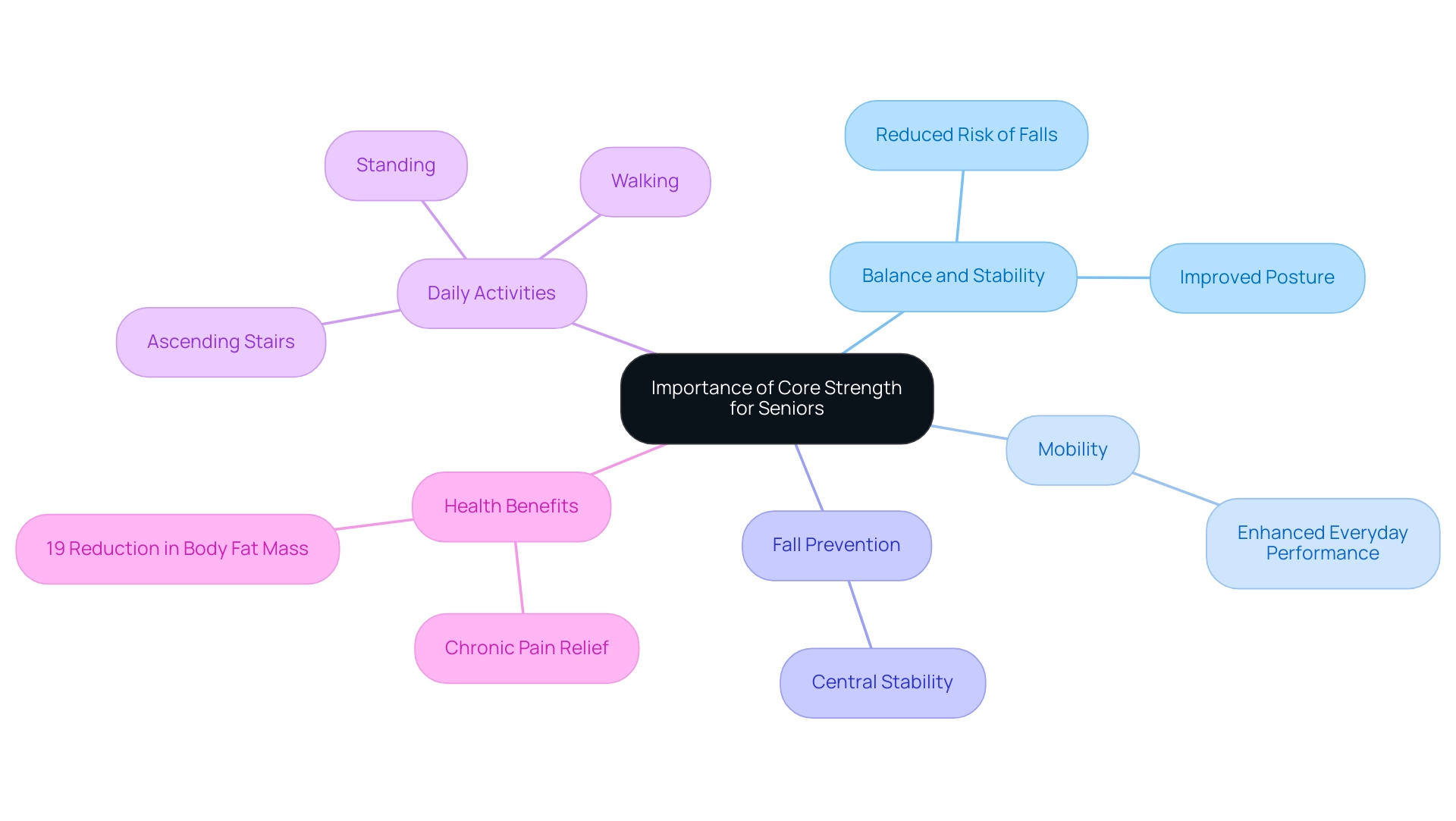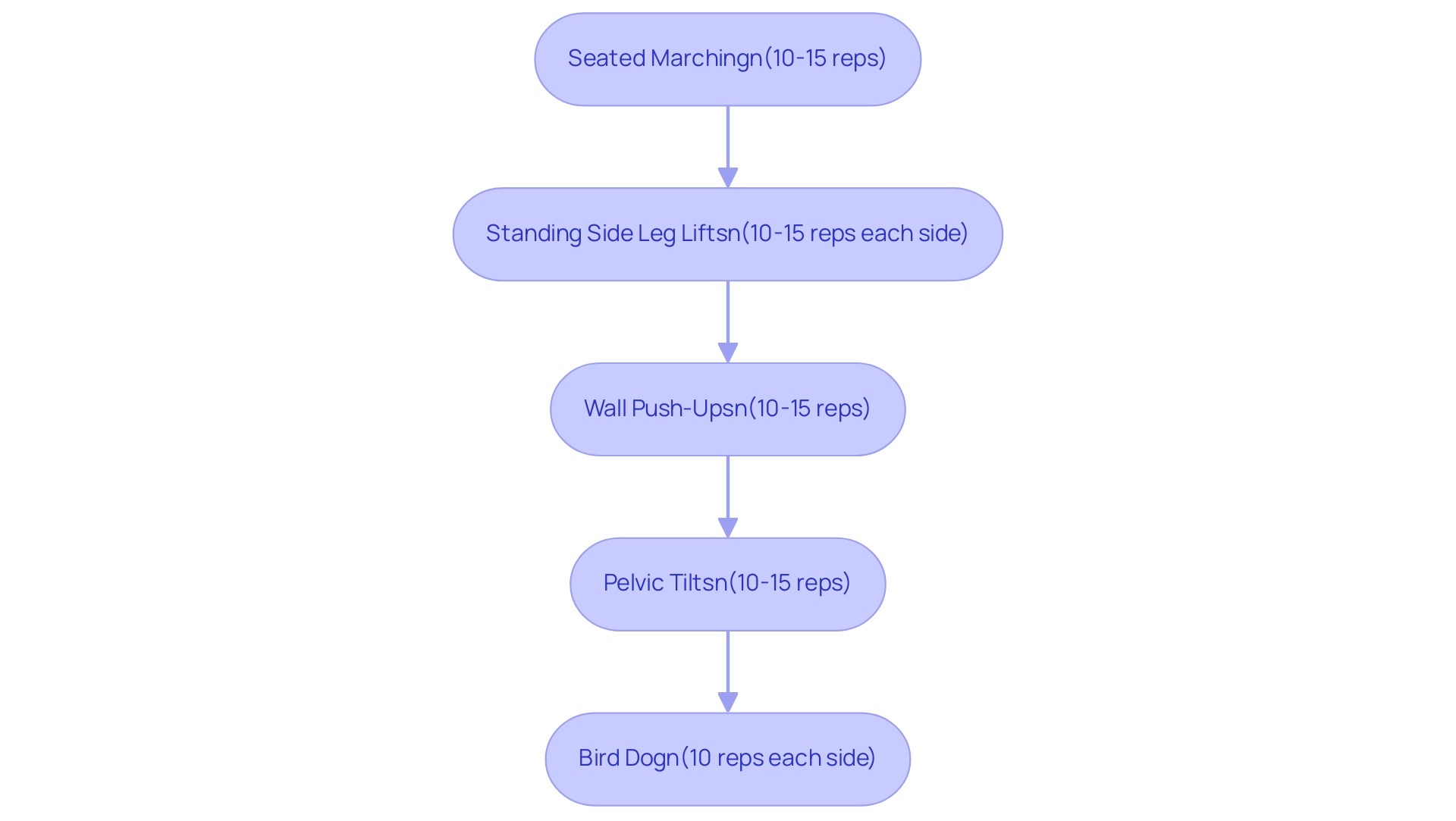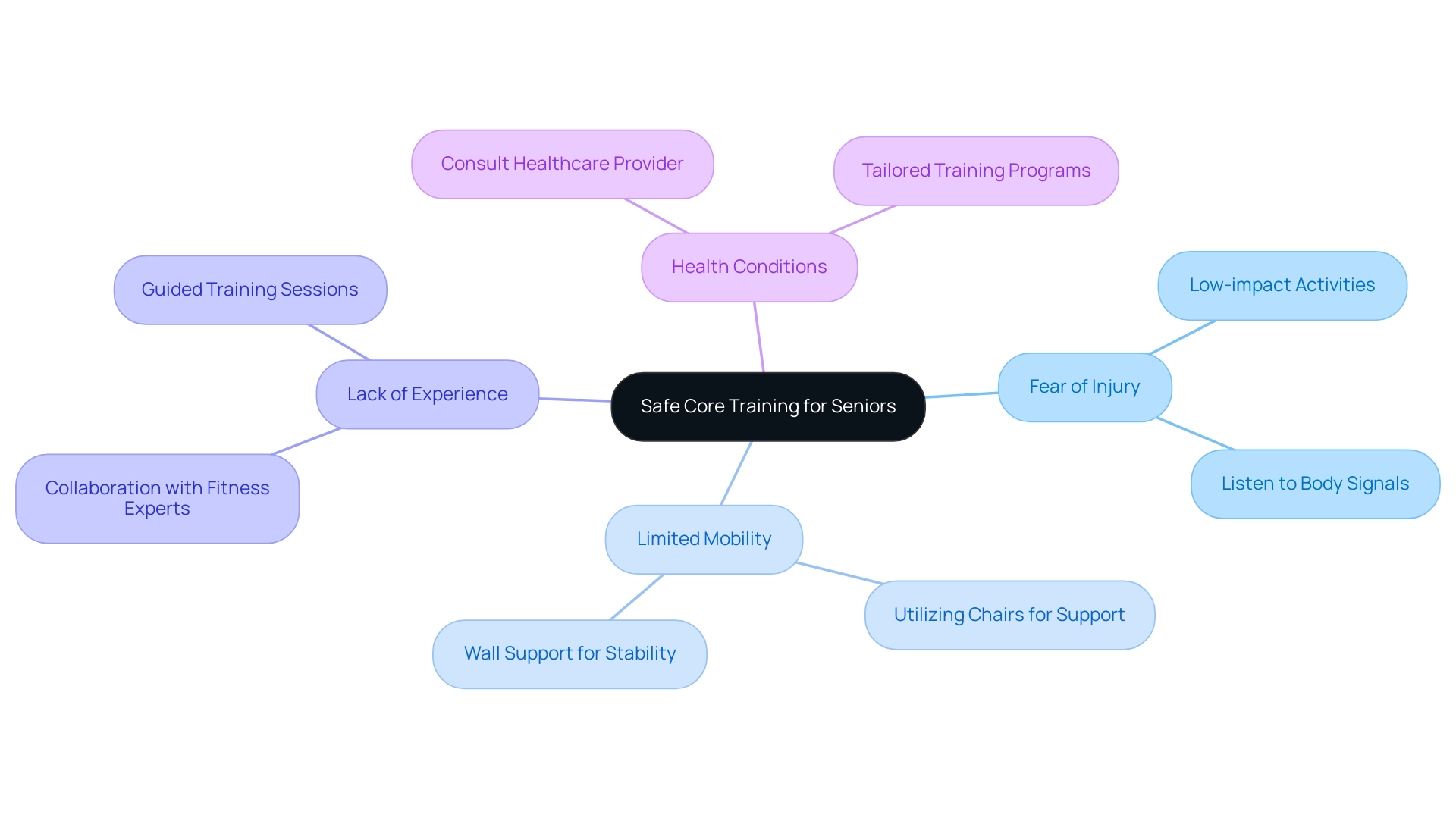Overview
Core strength for seniors can be improved through essential exercises that enhance balance, stability, and overall mobility, which are crucial for reducing fall risks and maintaining independence. The article outlines a variety of effective exercises and emphasizes the importance of consistency and safety in training, supported by evidence showing significant health benefits such as reduced back pain and improved quality of life for older adults.
Introduction
In an aging society where maintaining independence and quality of life is paramount, core strength emerges as a vital component of senior fitness. As older adults navigate the challenges of balance, stability, and mobility, the significance of a robust core cannot be overstated.
Strengthening this foundational area not only reduces the risk of falls—a leading concern among seniors—but also enhances their ability to perform everyday tasks with ease. With compelling evidence highlighting the benefits of core exercises, such as:
- Improved posture
- Diminished back pain
- Increased confidence
the call to action is clear: prioritizing core strength is essential for empowering seniors to lead healthier, more active lives.
This article delves into the importance of core strength for older adults, providing essential exercises, benefits, and strategies to safely incorporate these workouts into their fitness routines.
The Importance of Core Strength for Seniors
Core strength for seniors is essential, as it significantly impacts their balance, stability, and overall mobility. Core strength for seniors is crucial as it not only supports the spine but also reduces the risk of falls, which are a major concern for older adults. Recent strategies for fall prevention highlight the significance of central stability in preserving mobility and independence.
By enhancing core strength for seniors, they can improve their performance in everyday tasks such as:
- Standing
- Walking
- Ascending stairs
Significantly, an 18-month study discovered that strength training combined with diet led to a 19% reduction in body fat mass, emphasizing the broader advantages of foundational strength training. Furthermore, as highlighted in a crucial 2015 review, more than 50% of people in the U.S. experience chronic back pain, frequently associated with weakened abdominal muscles.
Reinforcing the center can reduce this discomfort and encourage improved posture, making it a safer and more approachable form of physical activity compared to conventional resistance training. As Peggy Pletcher, M.S., R.D., L.D., CDE, emphasizes, improving core strength for seniors is essential for maintaining their independence and quality of life. By prioritizing this aspect of fitness, we empower older adults to lead healthier, more active lives.

Essential Core Exercises for Seniors: A Step-by-Step Guide
To improve fundamental strength in older adults, here are some essential activities that promote stability and well-being:
- Seated Marching: Begin by sitting upright in a sturdy chair. Activate your abdomen and lift one knee toward your chest, then lower it back down. Alternate with the other knee, aiming for 10-15 repetitions. This activity not only enhances stability but also builds core strength for seniors while promoting movement.
- Standing Side Leg Lifts: Position yourself behind a chair for support. Maintain a straight posture as you lift one leg out to the side, then lower it back down. Repeat this movement 10-15 times on each side. This exercise engages the core strength for seniors while enhancing balance.
- Wall Push-Ups: Stand an arm's length away from a wall. Place your hands at shoulder height and perform push-ups by bending your elbows to lean in, followed by pushing back to the starting position. Aim for 10-15 repetitions. This activity effectively engages the upper body and central muscles.
- Pelvic Tilts: Lie on your back with knees bent. Tighten your abdominal muscles and gently tilt your pelvis upward, holding this position for a few seconds before releasing. Repeat 10-15 times. Pelvic tilts are excellent for enhancing core strength for seniors and building trunk stability.
- Bird Dog: Start on all fours, extending one arm forward while extending the opposite leg back, maintaining balance. Hold for a few seconds before switching sides. Repeat 10 times on each side. This activity is highlighted in a study by Masaki et al. (2015), which demonstrated that variations of the Bird Dog can significantly activate central muscles, with modifications yielding the highest muscle activity. As mentioned by Tarnanen et al., upper limb activities can effectively engage central muscles, making this a valuable addition to your routine.
Before commencing any new fitness regimen, particularly for individuals with pre-existing health issues, it is essential to seek advice from a healthcare provider to guarantee safety and appropriateness. According to McGill & Marshall (2012), participating in these activities is particularly relevant for older adults, as it helps maintain core strength for seniors along with overall health and functionality.

Benefits of Core Exercises: Enhancing Balance and Stability
Participating in fundamental exercises offers numerous advantages for older adults, improving their overall health and quality of life. Key advantages include:
- Improved Balance: A strong center is fundamental for stability, significantly reducing the risk of falls among older adults. Statistical analyses indicate that older adults who engage in activities focusing on core strength for seniors have a markedly lower incidence of falls, a critical concern given that fall rates remain a leading cause of injury in this demographic. A systematic review of fundamental training protocols found that exercises conducted more than twice a week resulted in a substantial effect size (ES = 1.55) in decreasing fall risk.
- Enhanced Mobility: With improved central stability, older adults can navigate everyday tasks more effortlessly, such as bending down or reaching for items. This newfound ease encourages greater independence and engagement in daily activities.
- Reduced Back Pain: Strengthening the core alleviates pressure on the spine, which can diminish discomfort and enhance overall physical comfort. This reduction in pain enables older adults to engage more fully in their lives.
- Increased Confidence: As older individuals develop greater strength and stability, they often experience a boost in confidence regarding their physical capabilities. This newfound confidence encourages them to stay engaged and seek a healthy lifestyle.
- Better Posture: Core activities promote proper alignment, essential for sustaining good posture and avoiding strain-related injuries. Better posture not only aids physical health but also boosts self-esteem and body awareness.
By incorporating core strength for seniors into their daily routines, seniors can experience significant improvements in their quality of life, as supported by evidence from recent systematic reviews highlighting the positive outcomes of various core training methods. The review emphasized that participation rates show the most notable effects when exercises are performed more than twice a week and consistently over a period of 16 weeks, with effect sizes indicating significant benefits (ES = 2.68 for duration greater than 30 minutes). Furthermore, the quality of the evidence backing these benefits was assessed using the GRADE method, offering a dependable framework for comprehending the significance of the findings. It’s evident that focusing on fundamental strength can result in substantial health advantages.

Addressing Common Concerns: Safe Core Training for Seniors
Ensuring safety during fundamental training for older adults is vital for promoting a positive and effective physical activity experience. Below are common concerns and proactive strategies to address them:
-
Fear of Injury: It's completely natural for seniors to worry about potential injuries. To alleviate this fear, begin with low-impact activities, enabling participants to develop their strength gradually.
Encourage them to listen to their bodies and stop any activity that causes discomfort.
-
Limited Mobility: Many core routines can be easily modified to suit various fitness levels. Utilizing chairs or walls for support can enhance stability and confidence, making the training more accessible.
-
Lack of Experience: Seniors may feel uncertain about how to perform specific activities. In such situations, collaborating with a fitness expert who focuses on older adult fitness can offer vital guidance and reassurance.
-
Health Conditions: Before starting any new exercise program, it is important for older individuals to consult with their healthcare provider, particularly if they have existing health issues. This ensures that their training is tailored to their individual health needs.
By addressing these common concerns with thoughtful strategies, seniors can safely engage in exercises that promote core strength for seniors, unlocking the numerous benefits it offers. Notably, a study from Penn State College of Medicine found that older adults participating in strength training at least twice a week experienced 46% lower odds of dying from any cause, 41% lower odds of cardiac death, and 19% lower odds of dying from cancer compared to those who did not. This underscores the profound impact that safe physical activity can have on longevity and overall health.
Moreover, it is vital to acknowledge that 4 in 5 of the most expensive chronic conditions in adults aged 50 or older can be prevented or managed through physical activity, highlighting the importance of consistent physical movement. As Elizabeth Y Rula from Healthways, Inc. aptly states,
The demonstrated benefits of SilverSneakers participation to both emotional and physical health measures denote the strong positive impact the program can have on the well-being of older adults.
Additionally, seniors should be mindful that rhinovirus can survive on gym surfaces for several days if not properly disinfected, highlighting the importance of hygiene in physical activity settings. By prioritizing safety and accessibility in essential training, we can empower older adults to embrace a healthier lifestyle.

Incorporating Core Exercises into Your Fitness Routine
Including fundamental workouts in a fitness regimen can be both simple and pleasurable. Here are some important suggestions to think about:
- Establish a Schedule: Aim to participate in fundamental activities at least 2-3 times a week. Consistency is paramount for building endurance and sustaining motivation, especially considering that only 31.8% of older adults with functional limitations meet physical activity guidelines according to BRFSS.
- Start Gradually: Initiate your routine with shorter sessions, around 10-15 minutes, then progressively extend the duration as comfort grows. This gradual method promotes a positive experience.
- Combine Activities: Pair core workouts with other physical activities, such as walking or swimming, to create a comprehensive fitness routine that enhances overall well-being. The National Institute on Aging highlights that alongside aerobic and muscle-strengthening activities, balance and flexibility practices are also essential for older adults.
- Monitor Progress: Keep a journal to record your workouts, tracking improvements in strength and balance. Celebrating small victories along the way will help maintain motivation and engagement. A case study on adherence rates in older women fitness programs found that motivation factors were significant, highlighting the importance of tracking progress and remaining engaged in the routine.
- Stay Connected: Explore local fitness classes tailored for older adults. These classes not only encourage physical activity but also offer chances to connect with peers and build a supportive community.
By applying these strategies, seniors can effectively integrate workouts focused on core strength for seniors into their routines, significantly enhancing their health and well-being. Research indicates that older adults with functional limitations are increasingly meeting physical activity guidelines, with adherence rates showing promising engagement in structured exercise programs. As HR Benefits Managers, you have the unique opportunity to champion these initiatives, inspiring older adults to prioritize their fitness and overall quality of life.

Conclusion
Core strength is undeniably a cornerstone of fitness for seniors, playing a crucial role in maintaining balance, stability, and overall mobility. By engaging in targeted core exercises, older adults can significantly reduce their risk of falls, enhance their ability to perform daily tasks, and alleviate chronic back pain. The benefits extend beyond physical health, fostering improved posture, increased confidence, and ultimately a higher quality of life.
Incorporating core exercises into a fitness routine is not only achievable but can also be an enjoyable endeavor. With a variety of accessible exercises and strategies to address common concerns, seniors can safely build their core strength and enjoy the profound advantages it brings. Regular practice, combined with a supportive community and a focus on gradual progress, paves the way for lasting health improvements.
Now is the time to prioritize core strength for seniors, emphasizing its vital role in empowering them to lead healthier, more active lives. By championing these initiatives, there is a tremendous opportunity to make a positive impact on the well-being of older adults, ensuring they remain independent and engaged in their lives for years to come.




